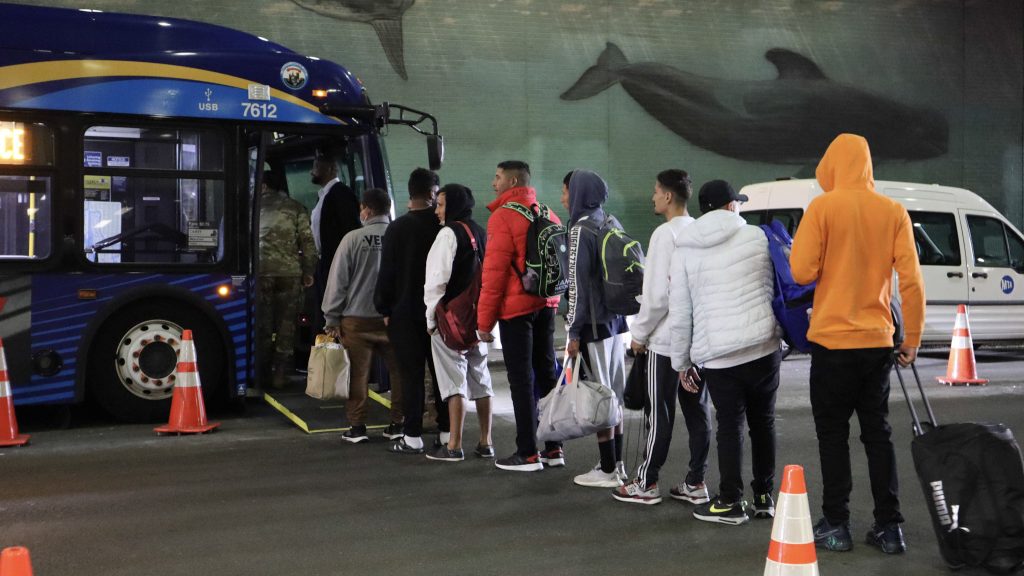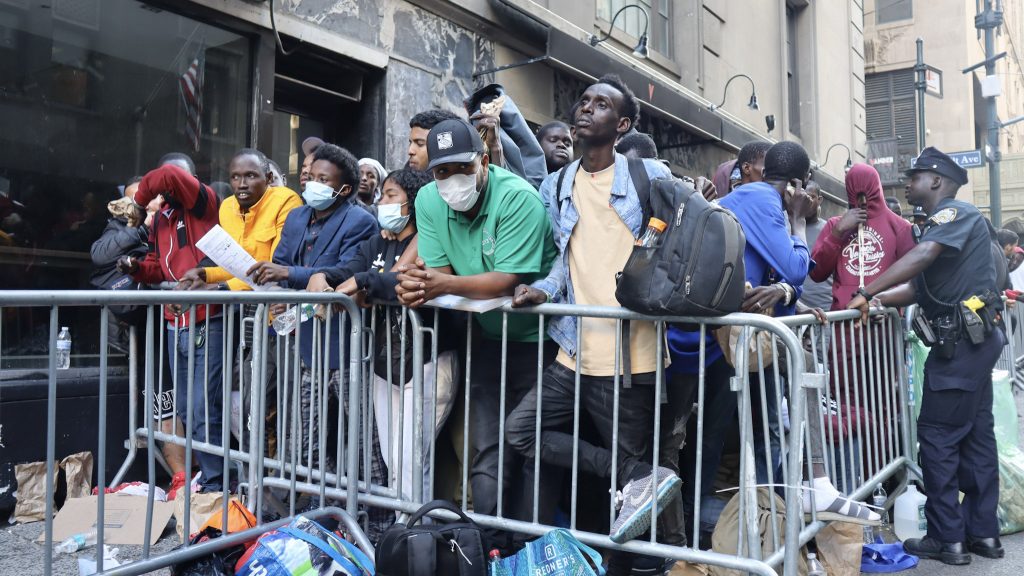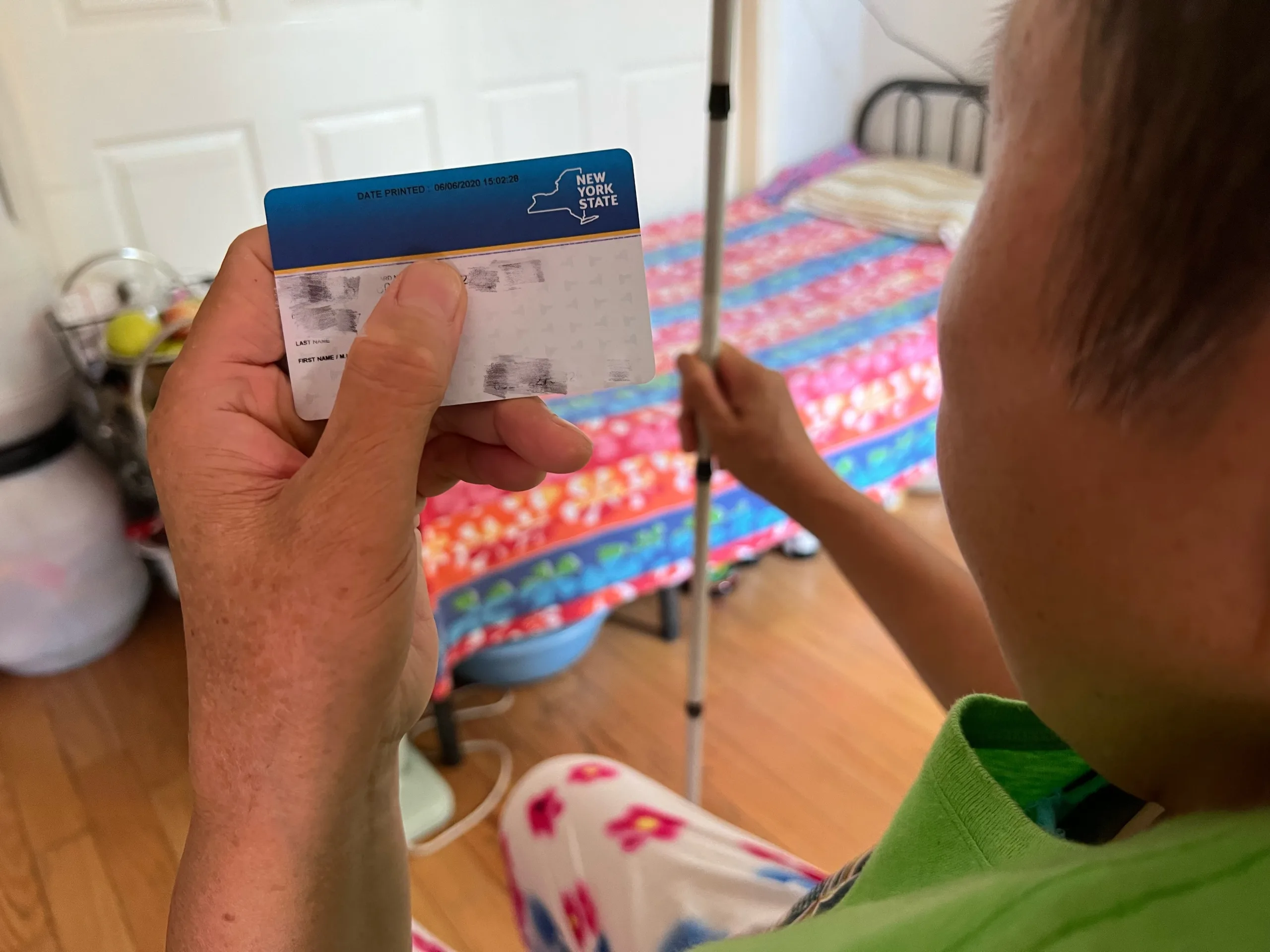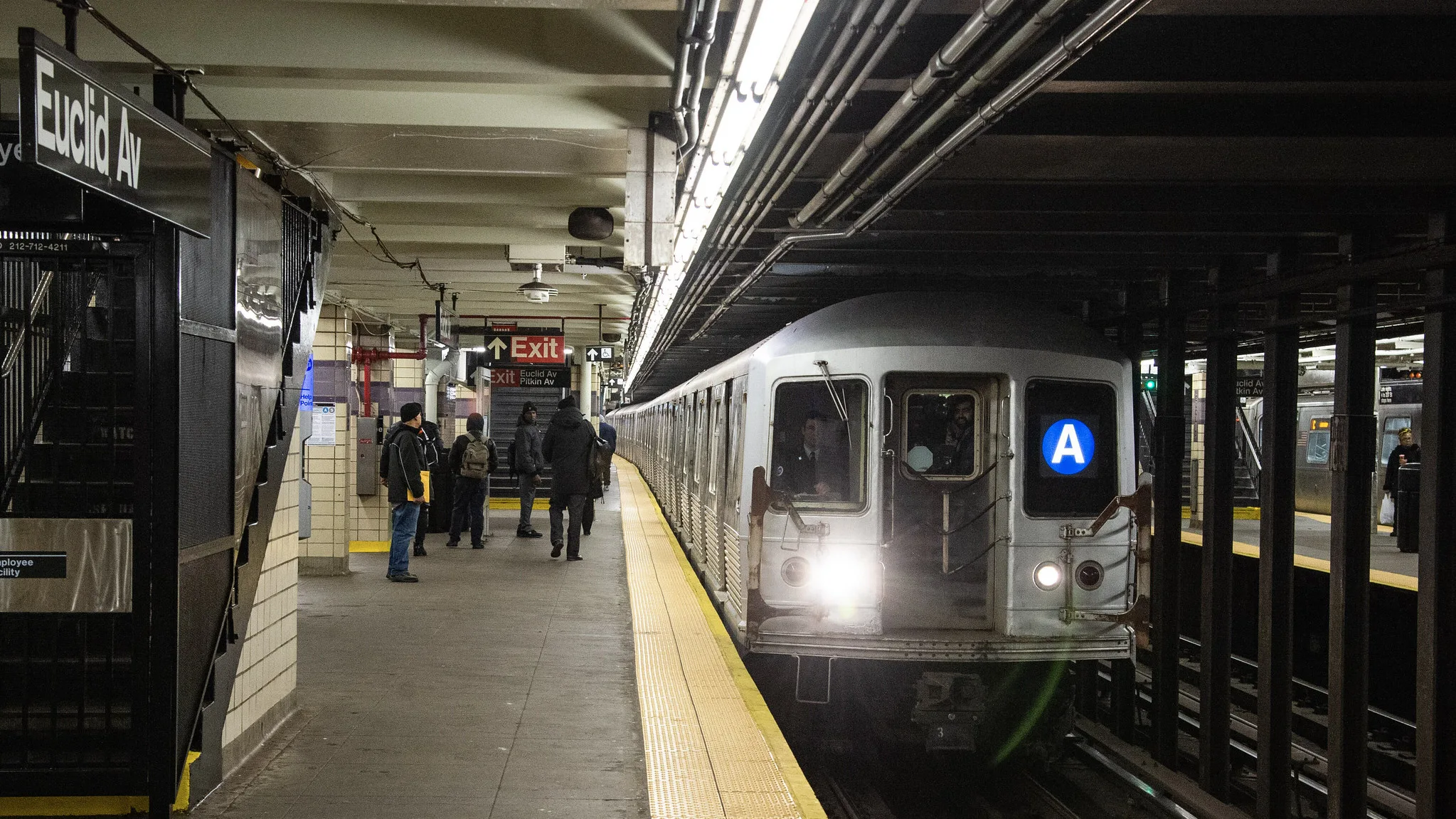This story was reported in partnership with El Paso Matters.
At the downtown El Paso train depot, a colorful map of the United States is taped to a pole, a reference point for migrants who often count the number of states that stand between Texas and their destination. Migrants are grouped in a back parking lot next to rows of portable toilets and pallets of bottled water. They line up according to their destination. Sometimes they wait, sitting on the floor, three to four hours for a charter to arrive.
Also Read: Migrants Continue Arriving in NYC, Despite Discouragement from Adams
On Tuesday last week, Luis Aguilar, 36, a street vendor from Guatemala, waited for information about charter buses alongside dozens of migrants from Venezuela, Honduras, Guatemala and other countries. He was looking to get to Dallas, where he has friends who could connect him to job opportunities. In Guatemala, he left behind his wife and three children, ages 1, 10 and 11.
Now, Aguilar wasn’t sure he was in the right place, having been told charter buses at that site, the Union Depot, likely weren’t going to Dallas. If he ended up in another city, he said, he may just go, find shelter and work, unauthorized, until he could find a way to Dallas. “It’s very confusing because we hear different things from people who arrived here before us, from different police and agencies,” Aguilar said in Spanish.
Migrants interviewed by Documented and El Paso Matters, like Aguilar, often arrive in Texas with no way to fund their journey out of border cities. Many rely on charter buses offered by cities like El Paso, and the state of Texas, to take them to New York, Chicago or Denver, among a handful of other cities.
Migrants said they chose New York or Chicago over the other cities because of family or community connections there, because it was their best option for work or because it was simply the first available free bus offered out of the area. Some said they didn’t have in mind any of the cities where charters were headed as their final destination, but they would opt to take free transportation to one of them, optimistic that they would get closer to their ultimate stop.
When Milagros Cuetos, 39, arrived in Texas last month after making the journey from Venezuela and being released from immigration detention, she said she chose to travel to New York from Brownsville, despite other options given to her, like Washington, D.C., because “there are more Latinos, and we are looking for work.”

After taking a roughly two-day journey on a chartered bus from Brownsville, Cuetos spent the night sleeping on a chair inside the shuttered bar next to the Roosevelt waiting to be placed in a shelter. “Sometimes, things aren’t like you think they’ll be,” she said one afternoon last week, sitting next to her 21-year-old son. “We ask God that here we’ll be able to make our new beginning, and that there will be a good future.”
National controversy erupted last year when Texas Gov. Greg Abbott began sending migrants across the country to Democratic enclaves in a political ploy. Since April 2022, Gov. Abbott has sent more than 55,500 migrants on buses across the U.S.
But Gov. Abbott’s political strategy has slowly become a methodical system of moving tens of thousands of migrants across the U.S. by bus, to still largely Democratic-controlled cities. Some migrants at the Roosevelt intake center in New York said they had final destinations in mind, but were using New York as a transit hub. Once in New York, they said they could still be processed by the city’s system and rely on city funds to travel elsewhere.
Yet, as cities continue to receive migrants and tensions rise about taxpayer dollars allocated toward them, the outsize role of Texas’ busing program transporting migrants to New York, with a cost of $75 million in taxpayer funds to one transportation company over a year, underscores how a lack of national coordination has also contributed to the local political conflict.

“New York City has managed this national humanitarian crisis almost entirely on its own,” a spokesperson for City Hall said in a statement to Documented. “We are in a humanitarian crisis that demands a broader state and national solution.”
More than 64,000 migrants are currently in the city’s care, and 10,000 are still arriving every month, the spokesperson said. About 600 migrants have been arriving daily to New York, City Hall said this week.
On Monday, New York Mayor Eric Adams announced that the city will be sending migrant families with children, who are living in city facilities, notices that they will have to seek other housing within 60 days. Floyd Bennett Field in Brooklyn will soon house about 500 migrant families in the coming weeks in a “semi-congregate” setting, the city said. The “current surge at the border” and “additional bussing from the State of Texas” has resulted in “an unsustainable spike of migrants arriving in New York City seeking shelter,” according to the Adams administration.
In September, Gov. Abbott restarted the state’s busing campaign from El Paso and Eagle Pass, adding to the already active operations in Brownsville, Del Rio, Laredo and McAllen, his office said in a Sept. 22 press release. Under Operation Lone Star, the Texas Division of Emergency Management has been chartering buses to New York, Philadelphia, Washington, D.C., Denver, Chicago and Los Angeles; though Texas has sent the highest number of migrants to New York. And in Chicago, a record number of buses recently arrived in less than a week.
According to figures from Gov. Abbott’s press releases, in the first week of September, Texas sent 400 migrants to New York. But in the first week of October, the state sent 2,100 migrants north, a growth of 425 percent, according to figures shared in Gov. Abbott’s press releases. In total, more than 20,000 have been sent to New York on state-funded buses from Texas since August 2022, Gov. Abbott’s office said last week.
Under Operation Lone Star, more than 4,400 migrants have been sent from El Paso to cities across the country, with a total of 90 trips as of Oct. 10, a spokesperson for Gov. Abbott said over email.
The Texas Division of Emergency Management “routinely works with local officials from the City of El Paso to coordinate the state’s migrant busing mission,” Gov. Abbott’s press secretary Andrew Mahaleris said. He did not provide a breakdown of charters by month or specific destinations.
Separately, the city of El Paso sent 175 charters and nearly 7,660 migrants to New York City, Chicago and Denver in the latest wave of transport from Sept. 23 to Oct. 15. Nearly one-third of those charters were sent to NYC. An El Paso city spokeswoman said the average cost per charter is close to $11,000 — more than $1.9 million during this time frame using that figure. Specific costs were not provided.
The Adams administration has focused its public comments regarding the migrant response on imploring individuals to settle in other cities, looking to temporarily relieve itself of its obligation to provide shelter to anyone who asks for it, and attempting to spread the word across Mexico, Colombia and Ecuador that the city has no more room in its shelters.
Also Read: Hochul, Adams Want to Modify NYC Right to Shelter Law as a Response to Migrants
Meanwhile, Texas is escalating its busing operations to New York and other cities, sending thousands of migrants in recent weeks directly to Manhattan.
In El Paso, many migrants looked to travel to other cities or states, like Houston, Miami, Tennessee, North Carolina and Kansas. A group of women going to New York City or Chicago said they chose those destinations because that’s where most migrants were headed. They could connect with them there to receive guidance on the system, and maybe find connections to shelter and jobs.
Earlier this month, when Adams met with various Latin American leaders, he repeated at a virtual press conference from Colombia what has become a common refrain in recent months: “We are out of room in our city.”
“We’re at a tipping point,” Adams said after flying over parts of the Darién Gap. “We don’t want people to take this dangerous trek to come to New York City.”

Despite Adams’ messaging, some migrants like Katiuska Carolina Villalobos said they were not deterred from coming to New York. Villalobos, 21, arrived in the early hours of Tuesday last week, alone with her 4-year-old-son, Kerwin, to the Roosevelt intake center. A friend in Texas had warned her to be careful about going to New York, because they might be asking Venezuelans to leave. But her husband, whom she had not seen in about two years, was waiting for her in the city, so she was resolute in coming to New York. A charter bus from El Paso helped her get there.
“I wanted to come on the bus because I don’t have economic resources. So it was something free,” said Villalobos, who is from Venezuela but was living in Colombia. The only other destinations she remembers being offered without charge in El Paso were Denver and Chicago, she said.
Johana Roa, who arrived in New York about three months ago on a bus from Eagle Pass with her husband and 2-year-old daughter, only remembers buses being offered to New York — not other cities — when they crossed into the U.S. Her husband had dreams of one day reaching the city, and both hoped they could find employment there. So they jumped at the opportunity. “People were saying that here, there was the possibility of work,” Roa, 23, said as she held her daughter, Ana Victoria, outside the Roosevelt.
Now, Roa, who is from Venezuela, works washing dishes when she can, and her husband delivers food across the city. They are still staying at the Roosevelt. “We took the initiative to see if here, we can get ahead in life — and I know that we can. You just have to have faith.”














